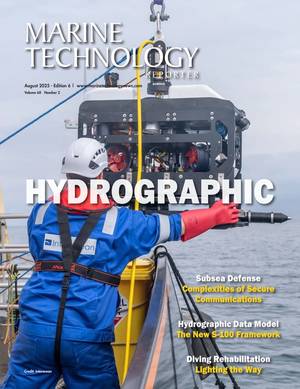
Torqeedo Provides Electric Propulsion System for Inland Shipping Research Vessel
with a twin-hull design. It will be capable of transporting both cargo and passengers. Its development and construction took approximately two years and it is powered by Torqeedo’s electric propulsion system. Four Deep Blue Batteries 80 supply energy to the two 50kW Deep Blue motors and all onboard systems. Torqeedo has provided a complete power management system with a dedicated low voltage power circuit for consumers like the autonomous navigation system, instruments and lighting, supplied by the high voltage system for propulsion. In addition, two coupled Torqeedo System Management Units in

Kongsberg Discovery Technology Sets Sail On One Ocean Expedition Research Voyage
from Bergen, Norway, on 11 April.The almost 100-metre-long vessel, Norway’s largest sailing ship, has been fitted with an array of Kongsberg Discovery technology to help scientists monitor and understand unique ocean environments, including the waters of the legendary Northwest Passage.Onboard systems now include 75 and 300 kHz ADCPs, EK80 Echo Sounders, an advanced hydrophone cluster, and the Seapath GNSS-aided inertial navigation system, while Blue Insight, a cutting-edge ocean data management and analytics platform, will process and share captured data with land-based teams daily. In addition

Robosys to Supply AI-driven Autonomous Control System for Legacy Marine USV
be launched from ashore or from floating platforms such as logistic support ships, frigates and other mothercraft, to perform patrol, surveillance, interdiction, search and rescue functions, amongst others.The USV features an aluminum hull, powered by a Volvo Penta D-6-400 engine, with steering and onboard systems, monitoring and controls, which includes payload and surveillance sensors. The USV is a versatile and multi-function platform that allows for the installation of most industry-standard sensors and effectors.The USV’s control system for autonomous navigation uses Robosys’ Voyager

USCG's Keeper Class Buoy Tenders Set for Navigation Upgrade
. Built on Exail’s Fiber-Optic Gyroscope (FOG) technology, the Octans gyrocompass will ensure highly reliable and precise navigation data, the manufacturer said. Complementing Octans, the Netans Data Distribution system will facilitate the sharing of navigation information across various onboard systems.Ted Curley, President and General Manager of Exail, said, “The supply of these gyrocompasses will add to the 100+ Exail navigation systems already operating in the USCG. It is a testament to our long-standing relationship with the USCG.”More than 100 Octans gyrocompass already equip

Vard to Build Second Cable Layer for Prysmian Group
;s ability to ensure its customers technological excellence, constant innovation and commitment to sustainability. Indeed, the highly demanding context in which the vessel will operate, both in terms of environment and hi-tech requirements, will enhance the sophisticated latest generation onboard systems. We are therefore particularly pleased to serve Prysmian – once again – with a successful project in a sector such as the cabling one, while supporting energy transition, which will attract investments in the near future.”Hakan Ozmen, EVP Project BU, Prysmian Group, said, &ldquo

SeaTrac Solar-powered USV Completes 800nm Offshore Loop in GOM
conditions encountered during the mission,” says Jill Storie, EddyWatch and SurveyWatch Program Manager at Woods Hole Group.The mission was run from the SeaTrac remote operations center in Marblehead, MA where the piloting team leveraged SeaTrac’s custom control software and the onboard systems for enhanced situational awareness. Four onboard cameras provided 360 degree viewing around the USV, while an AIS transceiver enabled the USV to broadcast its position and detect other vessels in the area. Real time USV health and status information were available to the operators, and alerts

New Product: SeaQ Remote for Autonomous Ship Ops
machinery systems such as engines, propellers and thrusters. Machinery is connected by sensors that can stream real-time data via the cloud to an onshore control center. Merged data from these sensors on a unified user interface provides a smarter way to gain an enhanced awareness of the status of onboard systems.Constant surveillance of OT systems using sensors also enables data-driven management of vessel operations with a fleet-wide overview from a centralized location to optimize overall operations, while cybersecurity safeguards are maintained to prevent system intrusion.For example, this allows

Maju 510 Tug: Singapore's First Autonomous Vessel Project Complete
operations among autonomous vessels, tests in live traffic, remotely supervised autonomous operation with improved port connectivity, and pushing and towing operations, the company said.As the systems integrator for the autonomous solutions, Keppel O&M upgraded the Maju 510 by digitalising onboard systems and processes, modifying the vessel, as well as integrating best-in-class technologies and enhanced systems connectivity.Chris Ong, CEO of Keppel O&M, said, “Autonomous vessels and technologies have immense potential to transform the nature of maritime operations. We are pleased

PLA, USS Support University College London Course
can access areas that weren’t accessible before to this level of survey capability, changing the way we survey the riverbed. It is battery powered so releases no carbon emis-sions and is robust enough to work in rough offshore and coastal conditions.”Using remote access capability to onboard systems, students from as far away as China, Saudi Arabia, and Singapore received daily interactive broadcasts from the Hydrographic teams aboard the PLA manned vessels M/V Maplin and M/V Thame to direct and participate in the project work. During the final week of operations, they were also able

 August 2025
August 2025





